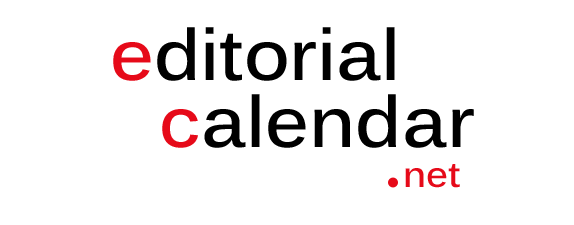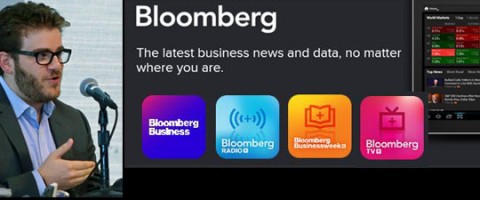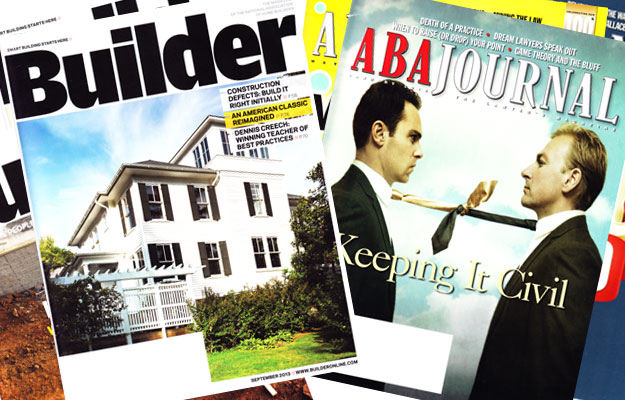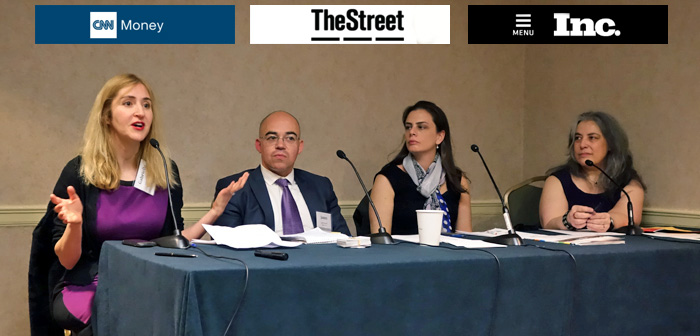June 23: NRF Protect
Pittsburgh. Loss prevention and cybersecurity experts attend this conference to share insights and strategies vital to the profession. Sponsored by the National Retail Federation.
Details: https://nrfprotect.nrf.com/
May 8: IMAG
Charleston, SC. Independent magazine publishers gather for the annual IMAG conference to share best practices, resources and learning unique to enthusiast brands. Peer-to-peer networking, coupled with intelligence on issues central to enthusiast brands and the wider industry.
Details: https://www.magazine.org/Magazine/Events_Pages/Conferences_Pages/IMAG_2019_Conference.aspx
May 7: ASBE
Chicago. The American Society of Business Publication Editors’ (ASBPE’s) 2020 National Conference and Azbee Awards Banquet is scheduled for May 7-8, 2020. ASBPE will offer a full day of conference on Thursday, May 7, followed by the Azbees reception and awards banquet in the evening. There will be a half day of conference sessions on Friday, May 8.
Details: http://www.asbpe.org/blog/2019/10/16/save-the-date-for-the-asbpe-2020-conference/
April 21: Magazine Innovation
University, MS. For nine years, the Magazine Innovation Center has brought industry leaders together for a three-day think-and-do experience.
Details: http://maginnovation.org/
Business Editors Face New Ethics Challenges

Participants in an ASBPE ethics panel at the National Press Club included (from left) Roy Harris, Beth Mirza, J.D. Solomon, and Warren S. Hersch.
What should you do when your publication’s sales reps request coverage of advertisers? How can you deal effectively with workplace harassment? And those new freelancers you’re taking on: How can you obviate conflicts of interest? Those were just three of the ethical conundrums addressed during the ASBPE’s annual conference at The National Press Club, Washington, D.C.
Conference attendees paid a good deal of attention to the growing erosion of the church-state wall between advertising and editorial. As vendors shift more of their budgets to the Internet, ad sales people are requesting more editorial favors to help move print space.
“In our world now, the concrete barrier between the editorial and advertising departments is more like a dotted yellow line,” said J.D. Solomon, Editorial Director at Professional Media Group. “Editorial is expected to sometimes go on the other side of it, but with caution.”
That caution arises from what Solomon called “two compelling and sometimes difficult to reconcile prime directives in B2B publishing.” The first is to maintain editorial integrity. The second is to avoid biting the advertising hand that feeds you.
“It’s not an easy line to navigate,” he concluded. “In fact, it’s a minefield.”
Editorial currency
Lying at the root of these conflicts, said Solomon, is the tendency of many sales reps to view company mentions as a form of currency that can be used to reward current advertisers and woo new ones. “The sales people like to send notes to their prospects saying, ‘Hey, guess what? You were mentioned in a story. Here's a link to it; isn't that nice? And by the way, maybe we should talk about some more advertising.’” More editorial mentions mean more sales. Hence the pressure for happy ink.
Solutions for the problem abound, some more effective than others. In a presentation titled “Navigating the Minefield of Editorial-Advertising Conflicts,” Solomon reflected on his experience directing the editorial departments of District Administration, published for school district leaders, and University Business, read by college and university leaders.
Solomon’s first stab at a solution was the introduction of a policy common to many other newsrooms: a prohibition on vendor quotes in published articles. The move was a practical one in this instance because Solomon’s magazines serve fields well populated with non-vendor subject matter experts.
While the new policy freed staff writers from much of the hounding to include favorite vendors in round-up features, the sales departments continued to feel advertisers should be recognized editorially in some fashion. Solomon responded with an Industry Viewpoint column presented as a sidebar separated visually from the regular editorial well. Because the vendors responded to specific questions on industry topics not directly related to their products, readers actually obtained useful information. “This has worked out well because it gets vendors into the publication in a responsible way.”

An industry viewpoint column presented vendor commentary on topics of vital interest to readers.
Maybe the Industry Viewpoint column was successful, but two problems arose. First, hard feelings resulted when vendor comments submitted past deadline had to be omitted. Second, so many vendors wanted to participate that the feature began to hog space. “It got to the point where we could have run two pages of quotes for each column,” said Solomon. Solution? He removed the column from the print product and posted it exclusively online. “Now we can include as many vendors as we want. And if a vendor misses the deadline we can just add the comments later. No one is the wiser.”
The sales reps are still not completely satisfied, admitted Solomon, since they often complain that the vendor comments are not in the print edition. “But at some point, you have to say, ‘Look, it’s a vendor mention, and it works.’”
The magazine has introduced another vehicle for the dissemination of vendor viewpoints: A paid-for Leadership Column, labeled as sponsored content, which vendors create with the help of the publisher’s content marketing department. This replaced a more traditional guest column which had consisted of unsponsored editorial copy, and which attracted too much vendor participation. “The Leadership Column has proven to be a workable solution,” said Solomon. “And the sales reps are happy because they get another product to sell.”
What’s new?
It’s among the stickiest of issues in the B2B field: How do you handle all those press releases touting new products, equipment installations, company awards and personnel advancements? While vendors crave the publicity, trying to be even-handed editorially can swamp any publication’s available space.
Solomon’s first attempted solution seemed reasonable: Include all the above materials in an Industry News section at the tail end of a daily e-newsletter aggregating material from other websites. Alas, this solution proved less than ideal because so much of the industry news consisted of personnel announcements and industry awards, inclusion of which made the e-newsletter far too large. So Solomon decided to limit the material to new product announcements and major new installations.
So far so good. But what about all those personnel changes and industry awards looking for a home? Solomon decided to house them in yet another feature. “We created something called a PR Portal online, where advertisers could post any press releases they liked,” said Solomon. While the portal consisted of paid advertising, regular advertisers could post press releases for free. It worked. “Now public relations agencies and marketing people get credit when they send emails to clients with links to their announcements.”
Solomon came up with another vehicle to meet the need: Each issue sports a feature describing how a half dozen or so educational institutions are implementing a specific vendor’s product. “It’s editorially written, there’s no fluff, it’s useful to our readers, and its’s very popular along the vendors.”
What’s hot?
As the above comments suggest, a lot of attention is paid to the topic of new vendor offerings. And it’s not just because advertisers crave coverage. “In B2B publications, new product information is important,” said Solomon. “How to handle the topic responsibly and ethically is always a challenge.”
At one time the publication published an annual Top 100 Products section selected by the editors. Problems arose as sales reps lobbied for the inclusion of their favorite vendors’ merchandise. To alleviate any sales-side pressure, item selection was removed from the hands of the editors and given to the readers in an annual Readers’ Choice poll.
What at first seemed like an ideal solution, though, introduced new problems. Very often top-quality products were ignored by responding readers while obscure items would end up with lots of votes. Since the result was less than useful to readers, the magazine replaced the Top 100 concept with an annual paid-for Advertiser’s New Products Showcase. Frequent advertisers are given free listings.
One more thing: Each issue sports a product focus section containing capsule descriptions of new products in a specific category. “Sometimes the products don't actually have to be new to get in,” notes Solomon. The presentation is kept plain, without any vendor logos, to encourage more paid advertising.
Urgent issues
Panelists at an ethics roundtable (pictured) addressed additional challenges beyond the erosion of the advertising-editorial divide. One was workplace harassment, a topic attracting renewed national attention today with the rise of the #metoo movement. “Harassment is any unwelcome conduct as determined by a reasonable person,” said Beth Mirza, Director of Online News Operations at the Society for Human Resource Management. “If you think some behavior looks bad, then it is bad. You're a reasonable person and you can report it.”
The important thing is to take action, said Mirza. “You need to say something to somebody. You can say it to the person who is harassing, you can say it to the person who's being harassed, you can say it to the manager, or you can say it to an HR person. That's what's going to stop a culture in which harassers are excused for their behavior.” Finally, said Mirza, there must be consequences for improper behavior, no matter what level of success the perpetrators are bringing to the business.
Warren S. Hersch, senior reporter for Money-Media and past president of the ASBPE, addressed the ethical challenges that can arise when an editor or writer takes an active role in a covered industry. While covering the life insurance field, Hersch himself had decided to become a licensed agent for the purpose of deepening his industry knowledge.
If such an initiative can lead to better reporting, it also poses significant conflicts of interest. For example, should any sales commissions be donated to charity? And should the writer be prohibited from reporting on any carrier for which he or she served as an agent? Hersch cautioned that such questions should be addressed before a writer ventures forth into a real-world venture.
Finally, Roy Harris, interim ASBPE Ethics Committee Chairman, addressed the tricky topic of vetting freelancers. This task has become more challenging and more vital in a publishing environment where a greater number of independent writers are chasing fewer jobs. As publication pay scales have flattened or fallen, a greater number of freelancers are shuffling gigs in public relations, sponsored content and journalism. More than ever, it’s easy for writers to inadvertently engage in conflicts of interest.
As a partial solution, some publications ask freelancers to sign ethics policies which require the disclosure of conflicts of interest. Others, faced with a limited number of freelancers who can write in a specific field, prohibit writers from covering specialty subsets for which they have received corporate monetary compensation.
Story by Phillip M. Perry
Posted June 25, 2018
Obtain more information about the ASBPE at http://www.asbpe.org/
Building a great B2B magazine
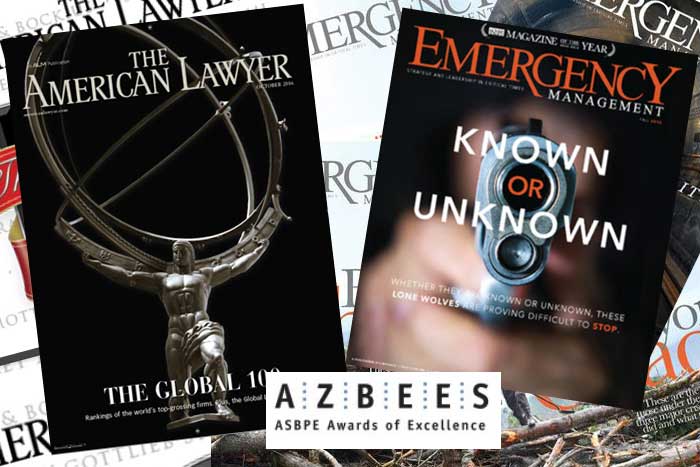 Offer exclusive content. Solve real world problems. Communicate with readers.
Offer exclusive content. Solve real world problems. Communicate with readers.
Common principles, all, at great business-to-business (B2B) magazines. In a recent webcast sponsored by the ASBPE, editors Kim Kleman of The American Lawyer and Jim McKay of Emergency Management spoke about the winning publications of the latest “Azbee” Magazine of the Year awards.
“Editing a B2B magazine is a tough job,” said Sam Oches, ASBPE webcast chair, in introducing the speakers. “From researching and reporting to management and strategic thinking, editors face a tall order in assembling a comprehensive product that is valuable to their readers.”
Gold content

Kleman
Start with unique value. “My first and foremost strategy is to give readers something exclusive, something they will pay a handsome fee for,” says Kleman.
For The American Lawyer, that something is a database loaded with forty years of numbers on matters such as law firm revenues, salaries, staff size, and profits per partner. Kleman believes this resource gives her publication a fundamental advantage over the competition. “I would counsel anybody out there: Find your audience and the things they're most interested in, then determine how you can offer something only you can provide. I call it gold content.”
The American Lawyer’s data cater to the competitive nature of the world's most elite lawyers. “They want to know how they're doing versus their competitors and how much their partners are making versus those at the firm down the road,” says Kleman.
The deep array of figures allows the magazine to reveal important trend information, adds Kleman. “How has this particular firm done over the years? What happened to the industry over the same period?”
Behind the numbers
Kleman emphasizes the need to dig below the surface: “It would be a boring magazine if what we wrote was just about numbers and facts and data and spreadsheets,” she says. Instead, the numbers serve to stimulate interesting topics. “With numbers as the underpinning we can really go deep. We may decide that we need to write about a certain firm, about the tick-tock of how it went down or how it rose to its current height. We can also do lawyer profiles within those firms. Which firms are exploring new strategies that seem to differ from the rest?”
Unusual initiatives are of particular interest to a field largely conservative in its business approach. “We love to do stories on things that are new and extraordinary,” says Kleman. “Maybe these don't rely as heavily on financial data, but they are certainly part of the conversation going on in law firm board rooms today.”
Here are some other tips from Kleman:
* Surveys such as The American Lawyer’s “Global 100” of top grossing law firms can help magazines stand out from competitors.
* Keep in touch with readers. “I try to get out and talk to my readers a lot,” says Kleman. “I typically have lunch or drinks or something two or three times a week with law firm leaders.”
* Have something fun at the end of the book. The American Lawyer, for example, has a column on the quirkiest lawsuits of the month.
Offer solutions

McKay
When it launched in 2006, Emergency Management filled a void. There was no publication devoted to news and analysis of government responses to hazards such as hurricanes, floods, fires and terrorism. “I think one of the things that really propels us as a publication and website is the dedicated readership,” said editor Jim McKay. “Our readers feel strongly about their profession. They tune in and pay attention. They let us know when they do or don't like something. That helps us. We listen. We don't want be arrogant.”
“We try to offer solutions in our stories,” said McKay. “What's working and what's not working? I think our readers appreciate the information we give them about what's happening around the country and what other people in the field are doing.”
Unlike The American Lawyer, this magazine makes extensive use of freelancers. “I have three or four freelance writers who've been writing for me for several years now, and I trust them,” says McKay. “They write the way I like stories to be written. I know each writer's strengths and weaknesses. They always come through for me. I pay them what I can to keep them. I see them as a huge strength in the magazine.”
McKay’s freelancers are mostly former newspaper journalists. “They've learned the rules,” he says. “They write concisely. They get to the point quickly. I like their active voice and no-nonsense style. It's something I think our readers appreciate, being first responders and emergency managers.”
In contrast, says McKay, industry experts will often get one aspect of a story down well, but fail to develop the big picture. “Sometimes the experts are biased. I really believe that if you have journalists who are well-schooled, tireless, and enjoy the subject matter, you can't go wrong.”
Paper and pixel
Both editors balance their online presence with the demands of their print magazines. “We try to use as much content as possible for each one of our mediums in its own way,” says Kleman. “We don't have the luxury of saying, ‘this is just for the magazine. It won't see the light of day online.’” For each new story, the staff asks questions such as: “Would this lend itself to some great video of people talking? Would this be a slide show online? Would this be an interactive chart? Then what would this concept look like for the magazine?"
While just about everything used in the magazine finds its way online, the reverse is not true. “There's a lot more that we publish online that can't, for space reasons, get into the magazine,” says Kleman. “We cherry-pick the best news of the month for The American Lawyer.”
Emergency Management also tends to emphasize breaking news online, says McKay. “The magazine articles, in contrast, look back at lessons learned from prior disasters and offer those to readers around the country.”
Story by Phillip M. Perry
Posted Jan. 17, 2017
Musical Background Informs Business Journalism
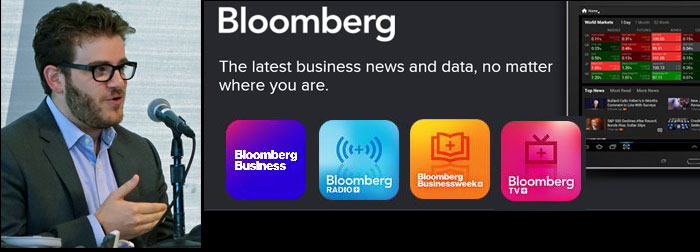 Maybe it’s a good thing Michael Shane worked as a professional musician before landing his current gig as managing editor at Bloomberg Digital. Editing for the web, it turns out, is something like playing Chamber jazz: A successful performance marries the improvisation of an Ornette Coleman riff to the discipline of a Bach cantata.
Maybe it’s a good thing Michael Shane worked as a professional musician before landing his current gig as managing editor at Bloomberg Digital. Editing for the web, it turns out, is something like playing Chamber jazz: A successful performance marries the improvisation of an Ornette Coleman riff to the discipline of a Bach cantata.
The self-expression part of that cognitive dialog, and its concomitant risk, is only too evident to any blogger who has hit the “post” key on the far side of prudence. “It's dangerously easy to say ‘yes’ to things on the web,” says Shane (pictured, above). Breaking news, after all, passes across the virtual desk all the time, and each item possesses its own allure. “You say ‘Oh, I'll just write that story.’ Ten minutes later it's out and your reputation is destroyed.”
The way to protect yourself (and your organization) is to harmonize the elements of self-discipline, training and skill. “At Bloomberg we have established clear routines for making decisions and working together,” says Shane. “That kind of discipline allows us to improvise when we need to. If you don't have a disciplined approach as a foundation, then when stuff hits the fan you won't have the flexibility to respond to it.”
All together now
Shane might well have absorbed another skill as he played his clarinet with the Cleveland Symphony: A conductor’s organizational talent. His current duties demand the coordination of Bloomberg’s multifarious story-telling initiatives across many digital platforms. Those include web-based magazines, radio, and television. Furthermore, each week’s paper edition of Business Week must be transmogrified into a web presence.
“We're talking hundreds of stories per day that have to find their way to the right place at the right time,” notes Shane. “Part of what I do is help everybody collaborate.” That means working closely with senior editors who receive copy from Bloomberg’s 2,600 journalists in over 70 countries.
The end goal, of course, is service to the reader. Shane estimates that over 50 million people visit Bloomberg’s digital platforms monthly. Giving them want they want can be quite a challenge.
Know your audience

Bloomberg business stories appear on a variety of devices.
What, come to think of it, do readers want? Shane addressed that question in these terms: “One of the very first editors I ever worked with on the web said ‘they don’t know what we know.’ That has always stuck with me. The audience doesn't know what we know. That's why they read our stuff. We can't forget that, whether we're thinking about story selection or angles.”
Telling what you know means, first, getting headlines early and accurate. “Breaking the news first and being right is really important, especially in a place like Bloomberg, where moving a story one second before a competitor can move a world market,” says Shane.
But headlines alone are insufficient. Thanks to burgeoning Twitter and Facebook feeds, breaking news has reached a state of such ubiquity that the provision of analysis has become equally important in making a web publication stand out. “The web audience wants an answer to the question ‘what does it mean and why does it matter?’” says Shane.
Enter the interpretative second day story. Writing a great one builds a reader loyalty that creates a foundation for additional value. “If you can't tell the second story, then you don't really put yourself in a position later on, to tell the feature story, the enterprise story,” says Shane. “You don't really have the credibility you need to participate in that conversation. On the web you have to build a robust track-record so you have work to refer to when you're telling longer stories, or you're looking at a story from a different angle.”
Cut to length
If news and analysis compose a story’s meaning, length is a critical element of form. Shane identifies two broad groups into which second-day stories fall. The first consists of succinct, efficient stories of fewer than 800 words. There’s a big audience for these, says Shane, largely because more people are reading stories on their smart phones, while commuting or walking down the street or sitting on their couch because they don’t want to go to their computers. The second group consists of enterprise stories of more than 1,000 words, for which Shane identifies a “nice big audience.” (And stories from 800 to 1,000 words? Shane banishes them to an “editorial wasteland).”
Given these two popular story lengths, the editorial conversation must include a consideration of the right format for each story. Even when a topic lends itself better to a shorter treatment, Shane spends considerable effort considering how to present it in the most powerful way. “This is something I think about a lot,” says Shane. “Does a story need to be 400 words or can it actually be a really phenomenal chart and three sentences? Or maybe a photo essay with captions?”
Stories that fall into the 800 to 1,000 word wasteland get special attention. Can the story be done with fewer words, or does it need more? Or can it be turned into two shorter stories? Finally, stories that appear to work best in long form are subject to further analysis. Might a 1,500 word piece, for example, be more impactful if split into three 500 word linked stories?
These comments suggest that length is a matter more of necessity than intent. “Short is not necessarily bad,” says Shane. “Short doesn't mean less smart. Short doesn't mean careless. Short just means that's how many words you need. You see this in any other discipline where you're making something out of thin air, whether it's music, or art, or film, or fiction-writing and story-telling. It really only needs as many words as you need, and not any more or any less.”
Give us long form
Now, how about those stories that really need to eat up the digital landscape? Given its reputation as a shorticle nirvana, it’s ironic that the web is more convenient than print for a long form treatment. Consider this: One of the most successful stories in the history of Bloomberg was a 38,000-word behemoth by Paul Ford titled “What is Code?”
 The article took up an entire issue of Business Week, and readers loved it. “Since we relaunched our site in January, ‘What is Code?’ had the highest level of user engagement of any story that we’ve ever published,” says Shane. Of course, that came as a surprise to many, not least because of the piece’s demanding subject matter. “It was an insanely long story that demanded a lot of its readers. The best stories ask a lot of their readers, I think.”
The article took up an entire issue of Business Week, and readers loved it. “Since we relaunched our site in January, ‘What is Code?’ had the highest level of user engagement of any story that we’ve ever published,” says Shane. Of course, that came as a surprise to many, not least because of the piece’s demanding subject matter. “It was an insanely long story that demanded a lot of its readers. The best stories ask a lot of their readers, I think.”
For the long form treatment to work, editors must know their audience. “The biggest conversations we had while we were planning that article was ‘Who is the audience?’” says Shane. “On one hand it was a very technical piece about the history of programming languages and how they work, and how they talk to each other, and where they're going. On the other hand, the story wasn't written for people who already know all that stuff.”
Lesson learned: The web lends itself to long form analysis when mandated by subject matter readers find compelling. “It was, I think, a heartening moment for everybody who works in media and journalism and story-telling,” says Shane. “It shows that there is absolutely room to do insanely ambitious off-the-wall things.”
Polymath playground
There’s another lesson learned from the Bloomberg experience: Today’s business writing thrives on diverse skills. “The digital newsroom is the perfect playground for the polymath of the 21st century,” says Shane. “If all you know how to do is write or edit, you're really not that useful to me in my newsroom. Today it's more important than ever to bring other skills.”
Such as? “We're looking for people who have an intrinsic understanding of social media and its place in the newsroom, who understand how to work with teams making video, and how to work with designers and developers,” he says. “So that when we're collaborating on something the process is as efficient and as fast as possible without sacrificing quality.”
As those comments suggest, technological knowledge should be part of the cognitive mix. Says Shane: “If I have a reporter and an editor who understand what CSS is and how it works, have experience working with video producers to tell stories, can go with the video team to shoot and interact with the subjects there, and have an idea in their head of what the video and the piece are going to look like in the end, that's going to be a much more efficient and successful collaboration.”
Mastery of diverse skills, then, fosters collaboration. And working well together, says Shane, is of paramount importance to a successful newsroom—especially one such as Bloomberg’s where so many stories move on so many platforms. “No story ever makes it to the web unilaterally,” he says. “There's always collaboration required, whether it's on the extreme end, like the Paul Ford piece, or something much simpler.”
Diverse backgrounds
The value of diversity extends beyond technical skills into broader knowledge fields. “In my opinion, nothing is more interesting than an unconventional background for a journalist,” says Shane. “I think that having a varying set of experiences, especially if you're working digitally, can be really helpful.”
Shane’s own musical background (he never attended journalism school), is, of course, a case in point. “As a musician I spent a lot of time in a room, by myself, playing an instrument to no one,” he says. “What I took from that was the value of planning. Practicing in music is really just planning. It's like putting money in the bank. You have a limited amount of time to do it and the way you spend your time has to be very thoughtful. It doesn't matter if you practice ten hours a day. If you're not thinking while you're doing it, and making decisions and drawing conclusions, then you're not going to get any better.”
Planning requires both creative thinking and self-control, qualities that Shane values to this day. “It is the rigor and discipline of working in classical music that I try to bring to the newsroom,” says Shane. “Which is weird for me because I'm actually a very zany, extroverted guy. But I think that working in classical music really grounded me and balanced me out.”
Shane instills into his staff a similar appreciation for discipline that provides the freedom to innovate. “I really, really believe that if you give people a process and tools they can rely on, when the time comes for them to be flexible and creative, muscle memory will take over and give them the space they need.”
--
This story is based upon a presentation by Michael Shane at a July, 2015 gathering of the American Society of Business Publication Editors (ASBPE) in New York City. The session was moderated by ASBPE president Mark Schlack.
Story and photo by Phillip M. Perry
Posted September 5, 2015
Making Native Content Work
Can business publications run native advertisinq without forfeiting their integrity? Three editors addressed that question in a recent webinar titled “The Rise of Native Content: How to Make it Work for Your B2B Publication Without Sacrificing Your Ethics.”
The webinar panelists seemed to agree that native advertising can be a legitimate money-maker for a magazine--as long as everyone involved plays by the rules.
 “We feel it's important to maintain our ethics and to not erode the quality of our main product,” proffered Joe Carbonara, Editor, Foodservice Equipment & Supplies, and Editorial Director for Zoomba Group. “We have established clear editorial guidelines in terms of what we will and will not accept from advertisers. And we consistently communicate these guidelines with our sales staff, with people we meet at trade shows and so forth.”
“We feel it's important to maintain our ethics and to not erode the quality of our main product,” proffered Joe Carbonara, Editor, Foodservice Equipment & Supplies, and Editorial Director for Zoomba Group. “We have established clear editorial guidelines in terms of what we will and will not accept from advertisers. And we consistently communicate these guidelines with our sales staff, with people we meet at trade shows and so forth.”
Road map
What makes an effective set of native advertising guidelines? The panelists zeroed in on two critical elements: Visual distinction and reader value.
For starters, native advertising must be distinguished visually from the traditional editorial well. An example of such a policy in action was offered by Kayley Bogdan, Project Manager, Custom Marketing Solutions, CSP Business Media: “While our native ads are formatted like articles, we include a sponsored content label with a ‘brought to you by’ or ‘from’ line so readers know the copy is from a sponsor.”
Additionally, sponsors are expected to avoid product puffery in favor of copy that provides readers with real value. “For us, so much of the success of our native advertising and content marketing lies in the relevance of the topic to our audience,” said Bogdan. “We look for content that's educational and informational on an industry level. Something that goes beyond a statement of product features, or of the benefits of a product or service--something that our audience is going to find really impactful and really effective.” Toward that end, Bogdan has created a document with branded content guidelines, made available to advertisers who want to contribute content on their own.
First principles
 As the above comments suggest, magazines looking to exploit native advertising feel the need to develop operational guidelines that obviate a poisoning of the editorial well. But that can require concerted deliberations. “When the digital side of our native advertising business started to take off we really struggled with how we should treat custom content,” said panelist Bogdan. “It is very different, after all, from the traditional paid advertising model because it appears in the editorial stream, and when that happens it kind of crosses that infamous grey area.”
As the above comments suggest, magazines looking to exploit native advertising feel the need to develop operational guidelines that obviate a poisoning of the editorial well. But that can require concerted deliberations. “When the digital side of our native advertising business started to take off we really struggled with how we should treat custom content,” said panelist Bogdan. “It is very different, after all, from the traditional paid advertising model because it appears in the editorial stream, and when that happens it kind of crosses that infamous grey area.”
Bogdan began by looking at what other companies in the food service B2B space were doing. Then a “custom content task force” was created to serve as a sounding board for the company’s native advertising and custom marketing initiatives. The task force included representatives from the digital, sales and editorial departments, all of whom worked together in a collaborative effort to develop the company’s custom marketing efforts. “We had a meeting of the minds to develop firm guidelines,” said Bogdan. “This led to a written document which we now use as kind of a Magna Carta, as a guide for developing all of our future native advertising products.”
The task force continues to oversee the publisher’s custom content initiatives. “I take new ideas for custom marketing or native advertising initiatives to our task force before we do any development work, just to make sure we're all on the same page,” said Bogdan. While task force meetings can be “a little heated,” in Bogdan’s words, she feels they are critical. “They allow us to consider all perspectives on how new native advertising initiatives might affect each part of our business. They also keep open the lines of communication so editors are not surprised when they see a new native ad on our web site. For us, it’s been absolutely key for everyone to know what's going on and to be in the loop.”
 It’s likely that enhanced communication between advertising and editorial will be critical to success for any magazine looking to exploit the potential of native advertising. “We haven’t dipped our toes into native advertising for our online publication yet,” said panelist Frank Kalman, Senior Editor of Human Capital Media, whose print magazines run occasional vendor-sponsored supplements. “We haven’t seen a huge demand from our vendors wanting it. Even so, it is something that we've continued to keep on the table and we've had discussions between sales and editorial about where we might be headed. We really have kind of taken away that strict church and state mindset when it comes to having open conversations about how native content needs to be handled editorially to maintain our own credibility and ethics.”
It’s likely that enhanced communication between advertising and editorial will be critical to success for any magazine looking to exploit the potential of native advertising. “We haven’t dipped our toes into native advertising for our online publication yet,” said panelist Frank Kalman, Senior Editor of Human Capital Media, whose print magazines run occasional vendor-sponsored supplements. “We haven’t seen a huge demand from our vendors wanting it. Even so, it is something that we've continued to keep on the table and we've had discussions between sales and editorial about where we might be headed. We really have kind of taken away that strict church and state mindset when it comes to having open conversations about how native content needs to be handled editorially to maintain our own credibility and ethics.”
Distinction with a difference
Native advertising initiatives tend to grow out of more traditional forms of promotion referred to as content marketing. This pedigree has led to a bit of overlap in nomenclature. Hence, one sometimes hears the native advertising label applied to promotional vehicles clearly divorced from the editorial well. Examples are the venerable “advertorials,” or stand-alone magazine sections filled with vendor-sponsored copy but distinguished visually from a publication’s editorial platform. Other examples are pages devoted exclusively to display ads in lieu of editorial copy, and vendor-sponsored speeches at live events.
Valuable as such initiatives may be, they are beyond the purview of native advertising in its pure form. The difference was addressed by panelist Howard Rauch, ASBPE Ethics Chair and President of Editorial Solutions. “There's only a slight difference, for me, between content marketing and native advertising,” he said. While both vehicles present the reader with high-value take-away information absent a ‘puffy’ hard sell, native advertising in its pure form erases the traditional visual barrier between advertising and editorial.
 “The initial point of native advertising was that graphically it really resembled regular editorial content,” noted Rauch. Even today, when native advertising has gentrified to include discreet warning labels, the promotional vehicle’s resemblance to a disinterested reporter’s output remains part of its charm. Indeed, the “native” in “native advertising” celebrates a family resemblance to that editorial copy native to a traditional print magazine. Little wonder, then, that native advertising is often referred to as native or sponsored content.
“The initial point of native advertising was that graphically it really resembled regular editorial content,” noted Rauch. Even today, when native advertising has gentrified to include discreet warning labels, the promotional vehicle’s resemblance to a disinterested reporter’s output remains part of its charm. Indeed, the “native” in “native advertising” celebrates a family resemblance to that editorial copy native to a traditional print magazine. Little wonder, then, that native advertising is often referred to as native or sponsored content.
Advertisers, for their part, exhibit an interest in native advertising that was largely lacking for old time content marketing. The reason? Maybe it’s the lure of the editorial well, or maybe it’s a fundamental change in the mindset of advertisers who are now more willing to soft pedal the hard sell.
Whatever the motivation, increased advertiser interest in native advertising has sparked the ethical challenges now facing today’s B2B publishers. Any publication looking to formulate ethical and practical guidelines, said Rauch, has not been helped by a policy shift at the American Society of Magazine Editors (ASME). “Earlier this year the association announced new editorial guidelines for native advertising that raised the roof,” he said. “The industry media blew their tops, concerned that editors had been sold out because they would now be forced to work directly on creating copy for advertisers.”
Rauch presented the webinar attendees with two slides. The first outlined the previous ASME guidelines with their clear statement that native advertising must be distinguished visually from editorial copy:
The new ASME guidelines, said Rauch, removed the specific language about type fonts and now state this:
ASME also recommends that native advertising on websites and in social media should be clearly labeled as advertising by the use of such terms as “sponsored content” or “Paid Post” and visually distinguished from editorial content and that collections of sponsored links should be clearly labeled as advertising and visually separated from editorial content.
That the guidelines now set a lower bar for visual distinction is bad enough, said Rauch, but there’s an even worse problem: “The missing link, and the thing that should concern everyone in this room, is the stipulation that editors should not be required to create any kind of content, be it native advertising or anything else. That is an issue.”
Rauch drew a contrast with the ethics code from the American Society for Business Publication Editors (ASBPE). The code, said Rauch, “allows for senior editors to engage in planning strategy for native advertising or any other form of sponsored content. Out of the question, though, is a requirement for editorial staff members to create ad copy. Unfortunately, not every publisher feels inclined to adhere to the advisory.”
In his final comments Rauch questioned the potential of native advertising for B2B publications. “Despite everything that we hear about it taking off and dominating and all of that, native advertising may be more attractive to the consumer side of publishing,” he said. “It's not necessarily clear that this is the biggest thing since sliced bread when it comes to B2B. It seems to me that a content marketing approach is the more logical way to go.”
--
Sponsored by the American Society for Business Publication Editors (ASBPE), the webinar was introduced by Jessica Zemler, ASBPE webcast committee chair and Digital Content Director with UBM Life Sciences Veterinary Group. Moderator was Pete Wiltjer, principal of The Pete Wiltjer Marketing Group. View the webcast at no charge; http://www.asbpe.org/blog/event/webcast-the-rise-of-native-content-how-to-make-it-work-for-your-publication-without-sacrificing-your-ethics/ ASBPE members can watch the on-demand webcast for free, and membership is now free for qualified B2B editors, writers, freelancers, and other professionals who work in business-to-business publishing. For more information on the ethical challenges of native advertising see the array of ASBPE ethical advisories at http://www.asbpe.org/ethics/
Story and photos by Phillip M. Perry
Posted June 11, 2015
Builder, ABA Journal Snag Top B2B Awards
Keep one eye open for better ways to serve your reader. And keep the other focused on new ways to leverage technology. That was the dual message from the winners of the 2014 Azbee Magazine and Web Site of the Year awards. On the morning after this year’s awards dinner on July 25 in Chicago, representatives from the winning organizations covered highlights of their efforts for ASBPE members.
 SHRM Online (shrm.org), owned by the Society of Human Resource Management, won the Azbee award for B2B Website of the Year. Beth Mirza, the organization’s Manager of Online News Content, highlighted a number of recent site improvements, all of which were intended to better service the organization’s core membership of HR professionals.
SHRM Online (shrm.org), owned by the Society of Human Resource Management, won the Azbee award for B2B Website of the Year. Beth Mirza, the organization’s Manager of Online News Content, highlighted a number of recent site improvements, all of which were intended to better service the organization’s core membership of HR professionals.
Ease of use has become of primary concern, said Mirza. One of the most visible improvements was optimization for mobile. Rather than creating an app, the organization modified its website to be screen size responsive. “Now the site looks good on a cell phone as well as a tablet and a computer,” Mirza said. SHRM also cleaned up its front page, among other changes introducing much shorter headlines.
One of the most challenging tasks was the improvement of an awkward and ineffective search function. “This took a long time to accomplish,” she said. “The IT, editorial and other content producers all had to work together.” To facilitate interdepartmental cooperation SHRM created a small search committee consisting of one person from IT, one from editorial and a couple of people from other departments.
The website has an easily spotted “Top News” section along the left side of the screen, and a lot of content is highlighted in a top-of-page marquee. The site’s content is divided into a taxonomy of HR topics and strategies easily accessible on the left side of the screen via drop-down menu.
Data as a resource for driving decisions and strategies has become much more valuable at Builder, winner of the Azbee Award for Magazine of the Year in the $3 million-plus category. “We have become very data driven at Builder,” said Jennifer Lash, Chief Content Manager at publisher Hanley Wood. In 2013 HW acquired Metrostudy, the nation’s leading provider of primary and secondary housing industry market information. Much of the editorial in the publication is now supported or inspired by this vast resource. “Our goal is to use the data for departments, for features, and anywhere else we can,” said Lash. “We even have some data journalists on staff whose job is to fully understand what Metrostudy can offer us and to pull that information and figure out the best way to present it.”
As for the future, it’s full speed ahead for Builder: “We are constantly looking at how to better serve our audience,” said Lash. “We plan to launch print and web redesigns in November.”
ABA Journal
Some magazines may foster a reputation, by design or by default, of being dry and stuffy. Not so the 100-year-old ABA Journal, winner of the 2014 Azbee Magazine of the Year award in the under-$3 million revenue category.
“ We try to look at legal issues as we would hope a good popular magazine would,” said Allen Pusey, the magazine’s Editor and Publisher. That means not only writing in a clear and bright style but also eschewing technical material in favor of topics that are broadly relevant--and sometimes edgy. The magazine recently ran stories on the efforts of state legislatures to corral court decisions, the need for national forensics standards, and how the chief prosecutor for the Gitmo military commission applies, in Pusey’s words, “his considerable personal integrity to a system based on torture.”
We try to look at legal issues as we would hope a good popular magazine would,” said Allen Pusey, the magazine’s Editor and Publisher. That means not only writing in a clear and bright style but also eschewing technical material in favor of topics that are broadly relevant--and sometimes edgy. The magazine recently ran stories on the efforts of state legislatures to corral court decisions, the need for national forensics standards, and how the chief prosecutor for the Gitmo military commission applies, in Pusey’s words, “his considerable personal integrity to a system based on torture.”
The magazine has also introduced departments such as “Hearsay” with entertaining short items and “The Docket” which includes Supreme Court or Appellate Court decisions or issues coming up in the courts that are of general interest.
An annual August issue has a cultural section with topics such as the greatest novels that deal with legal subjects and the best movie scenes that instruct people in legal matters. It sponsors, in conjunction with the University of Alabama and the National Book Festival, the Harper Lee contest for the best work of fiction about lawyers.
The magazine has redesigned its website for a more modern look and an improved search and navigation system. “We have also integrated the structure and the philosophy of what the magazine does with the news site,” says Pusey. “The magazine is the news site and the news site is the magazine. We work hard at this.”
Story and photos by Phillip M. Perry
Posted August 28, 2014
On Internet publishing sites, readers hold sway
“Do readers like our stories?” That time-honored query of the conscientious editor was once answered informally by the occasional angry letter from—or casual chat with—a subscriber. In the best of times an editor would seek wisdom from runes scratched into reader surveys received months after articles appeared in print.
Thanks to the Internet, the editor now receives an answer pronto. Online business publications receive instant reader response—not only when a new story is posted but also when its headline and copy are fiddled with in an attempt to create a more compelling package. The feedback arrives in the forms of mouse clicks and social media shares. How many? The more the better.
Readers, in essence, have crept out of the shadows to take a seat at the editorial desk. Three business editors discussed the resulting challenges at a panel titled “Meet the Editors: Business Journalism,” held in April at the annual conference of the American Society of Journalists and Authors (ASJA). Panelists (pictured left to right) were Gabrielle Solomon, assistant managing editor of CNNMoney.com; James Rogers, managing editor of TheStreet.com; and Allison Fass, deputy editor of strategy and business development at Inc.com. Moderator Minda Zetlin (pictured far right) is president of the ASJA and author of the “Start Me Up” column on Inc.com.
View me
One measure of reader response is the page view, or a request via mouse click to load a web page. During the first couple of weeks after publication a good story at Inc.com might receive 10,000 page views, and a stronger one as many as 100,000 to 250,000. “Over many, many months it's possible for an article to be accumulating tons of page views,” noted Fass.
In the quest for more page views the chief weapon is a great headline with a high profile subject. “It's the bigger, sexier stocks that move the needle for us,” says Rogers, pointing to examples such as Apple, Netflix, Amazon, and Tesla. “You could write about those stocks all day and still get quite a decent return.”
Little wonder that editors and writers spend a lot of psychic energy discovering the relative powers of various headline wording. Even the right word placement can make a difference: Will more people load a story, for example, if the word “Tesla” appears at the beginning or at the end of a headline?
Please share
As important as is the page view, many publications thirst after the more powerful quarry of the social share. Here the question extends beyond self-interest: Is a particular story so valuable that readers want to tell their friends about it? Shares trump clicks because of their power to expand the market reach of a publication exponentially. “Any article that's getting shared a lot is scaling our traffic,” says Fass. “It’s growing our potential traffic by many magnitudes if all those other people are also sharing the story on our behalf.”
 Potential stories, then, are weighed on a scale of sociability. “Something we always think about is whether a story is a ‘talker’,” says Solomon. “Is this something that people are going to be discussing in the elevator or when they get home with their family? Are they going to say, ‘Oh I read this great story on CNNMoney.com about big ass fans.’ We want to be part of that conversation.”
Potential stories, then, are weighed on a scale of sociability. “Something we always think about is whether a story is a ‘talker’,” says Solomon. “Is this something that people are going to be discussing in the elevator or when they get home with their family? Are they going to say, ‘Oh I read this great story on CNNMoney.com about big ass fans.’ We want to be part of that conversation.”
The editors prime the social pump through aggressive posting, especially on Twitter which receives a post for every story published on all three sites—and in the case of Inc.com, two or three posts. Other media are not ignored: About 30 percent of the posted stories at Inc.com, for example, go on to Facebook and LinkedIn.
As popular as it is, Twitter presents editors with the challenge of striking while the iron is hot. The need to post quickly is felt especially at TheStreet.Com which deals with market changing information. “The window in which a story is hot on Twitter is about seven minutes,” says Rogers. “Editors have to work with our social media teams to make sure stories go up in the correct period of time. Otherwise we miss that window.” The ordeal is worth it: “If you hit that window it can be page view gold.”
More is better
Unlike their print cousins, Internet sites are not constrained by the paper margin: Content can go on seemingly forever without fear of overextension. That means as many stories can be posted as can be created. “Since we have no print costs, whatever we can publish, as long as it’s quality, is good,” says Rogers. Such freedom is bound to carry with it a growing pressure to pump out copy. TheStreet.com wants to increase the number of stories it publishes, which has risen from a daily total of around 80 or 90 a year ago to a current level of nearly 130. “My bosses want me to increase that by 30 to 50 more titles a day,” says Rogers.
 The pressure to produce is mitigated somewhat by the length of the online story—which is seldom longer than 700 words at any of the three sites. Yet the need to engineer the production of so many story starts can put pressure on the staff. “We've got two teams of editors,” says Rogers. “One is for the newsroom which is very small—maybe two or three people. Then we have another team that works specifically with our contributors. There are only about seven or eight of those working in shifts throughout the day, and they're dealing with huge amounts of copy.”
The pressure to produce is mitigated somewhat by the length of the online story—which is seldom longer than 700 words at any of the three sites. Yet the need to engineer the production of so many story starts can put pressure on the staff. “We've got two teams of editors,” says Rogers. “One is for the newsroom which is very small—maybe two or three people. Then we have another team that works specifically with our contributors. There are only about seven or eight of those working in shifts throughout the day, and they're dealing with huge amounts of copy.”
Much of that copy comes from outsiders. Indeed, TheStreet.com has been trimming its staff of from 12 to 20 journalists in favor of utilizing more outside writers. Today the site draws regularly from nearly 40 regular contributors whom Rogers refers to as “inner sanctum” members. If the additional sources who supply occasional pieces are thrown into the pot the total comes to nearly 180. And fasten your seat belts: “We want to increase that three, four or fivefold,” said Rogers.
TheStreet.com is not alone in pulling copy from an impressive number of freelancers: Inc.com, for example, has over 100 contributors. Of course a Content Management System (CMS), into which writers input copy directly, can streamline the workflow dramatically. “It used to be that people would email us all their copy,” says Rogers. “We have done a lot of work on our CMS as a means for increasing our workflow, getting more content, and attracting more contributors.”
Writers, for their part, are expected to be more entrepreneurial and to take on more of the editorial tasks from fact checking to headline writing and SEO optimization. “A lot of the editing process is starting to fall back on the writers themselves,” says Rogers. “Things like working with headlines to generate more clicks, improving leads, and optimizing copy for search engines—we just don't have as much time to work with that stuff as we would like.” And many writers are falling into line. “We're seeing a new rash of contributors come through who are very familiar with a lot of these things,” says Rogers. “They use Google Trends, for example, to work out which headlines are going to be best for them.”
The human factor
The right headline can inspire more mouse clicks, but what do readers want in subject matter? Given the impersonal nature of the Internet, and of technology and business in general, it is perhaps ironic that human interest and personal fulfillment stories seem to be attracting more attention than ever. “A lot of the stories that I'm reading and doing on the Inc.Com site seem to be what I wouldn't have thought of as business stories a few years ago,” says moderator Zetlin in pointing to such themes.
 “A lot of our best content is broadly about productivity and the development of habits that make you successful at work,” says Fass, noting that today’s most popular topics include the need for charisma, what to do and say every day to be the best that you can be, the habits of happy people, and how to be more productive.
“A lot of our best content is broadly about productivity and the development of habits that make you successful at work,” says Fass, noting that today’s most popular topics include the need for charisma, what to do and say every day to be the best that you can be, the habits of happy people, and how to be more productive.
The reason? “These topics are really popular among the entrepreneurial community in New York and Silicon Valley,” says Fass. “Startups are talking about these ideas in terms of how they affect company culture and why that matters to growth and success as an organization.”
A good example of this trend was the popularity of a recent Inc.com story titled "The Psychological Price of Entrepreneurship" by Jessica Bruder. Editor Fass notes that the story is “all about the psychological struggle of starting your own company, and also in some cases a tendency for the type of people who might have psychological issues to become entrepreneurs. It's a very interesting, very well written and reported piece.”
Fass is heartened that the story “has been one of our most trafficked pieces of content on Inc.com since it went up. It continues to perform very well organically, and every time that we promote it again through social media. I am passionate about serious journalism and I love the fact that it can get a lot of traffic.”
Moderator Zetlin concluded that a successful online business story requires three factors. The first is a headline, written for human eyes, which is “so compelling that you absolutely can't resist the urge to click on it.” The second is a title (which appears at the top of the browser window) optimized for SEO algorithms. The third is what might be defined as sociability: “What really makes a story successful is that once you've clicked on it and read it you have also an uncontrollable urge to send it along to your friends or your social media circles.”
The Inc.com story about the price of entrepreneurship provides a case in point. “It's reporting from inside this interesting world of startups,” says Zetlin. “It's about business, and at the same time it's very intimate and very human.”
Story and photos by Phillip M. Perry
Posted June 11, 2014
